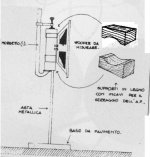To my knowledge, standard procedure has it that the driver be mounted vertically. Also, it should be attached to something solid. lest it move.
Eric
Eric
Claudio, it is not correct to suspend the woofer for measuring the impedance. You will get a slightly different answer compared to when rigidly held. Additionally, depending on the cone mass and suspension compliance you will get a different answer with the driver horizontal versus vertical, due to the suspension sagging under the action of gravity on the cone mass. This changes the position of the coil in the gap, changing Bl.
Being even more picky, the driver should be mounted on a large baffle, so that the air load mass on the driver is closer to the value that would exist when mounted in an enclosure.
Now of course this is all being pretty anal, because many measurement/analysis systems out there are not accurate or consistent enough to reliably assertain the differences.
Also, Thiele/Small parameters are not an accurate enough representation of the true low frequency performance for these small differences to matter anyway.
Andrew
Being even more picky, the driver should be mounted on a large baffle, so that the air load mass on the driver is closer to the value that would exist when mounted in an enclosure.
Now of course this is all being pretty anal, because many measurement/analysis systems out there are not accurate or consistent enough to reliably assertain the differences.
Also, Thiele/Small parameters are not an accurate enough representation of the true low frequency performance for these small differences to matter anyway.
Andrew
Thanks guys,
so I have to set the driver vertically, and using two tables - one on each side of the woofer - and clamp the frame to the two tables (two clamps, therefore).
Sounds good to you?
Claudio
so I have to set the driver vertically, and using two tables - one on each side of the woofer - and clamp the frame to the two tables (two clamps, therefore).
Sounds good to you?
Claudio
Frequency response is measured with a large baffle, but isn't the Thiele-Small procedure done without a baffle?
Andrew, take a look at the pic to explain what I meant about the clamps.
I have done some tests, with the driver in horizontal and vertical position, and the result is that vertical positioning gives an higher impedance peak, closer to the datasheet value.
Eric,
T/S parameters are taken in free air, without baffle.
To get the Vas you need to use the ADD MASS method, or the CLOSED ENCLOSURE one.
Then comparing the 2 impedance response, free air + mass add or CE, you get the T/S parameters.
At least this is the way SW works.
Claudio
I have done some tests, with the driver in horizontal and vertical position, and the result is that vertical positioning gives an higher impedance peak, closer to the datasheet value.
Eric,
T/S parameters are taken in free air, without baffle.
To get the Vas you need to use the ADD MASS method, or the CLOSED ENCLOSURE one.
Then comparing the 2 impedance response, free air + mass add or CE, you get the T/S parameters.
At least this is the way SW works.
Claudio
Attachments
- Status
- Not open for further replies.
- Home
- Loudspeakers
- Multi-Way
- Woofer testing

